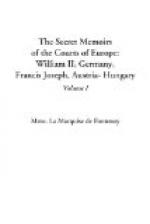The procession is opened by choristers, then come priests and monks with hands crossed upon their breasts, next the rectors of the various metropolitan parishes, displaying their distinctive banners like the knights of old. The municipal authorities, the officers of the imperial household, the Knights Grand Cross of the various orders, the cabinet ministers, and the principal dignitaries of the army, of the navy, and of the crown. Finally, comes a magnificent canopy borne by generals, under which walks the tall and stately Cardinal Archbishop of Vienna, carrying the Host, to which the troops lining the route bend the knee while presenting arms, the civilians behind them baring their heads, while the women cross themselves. Immediately behind the Host, bareheaded and alone, with a lighted candle in his hand, and wearing the full uniform of an Austrian field marshal,—a snow-white cloth tunic with scarlet and gold facings,—strides the aged emperor, still erect as a dart, with all the slender, shapely elegance of a man of thirty, in spite of his three-score years and ten. He is followed by the archdukes, conspicuous among them the gigantic Archduke Eugene, grand master of the Teutonic Order, in the semi-ecclesiastical habits of his rank, while the procession is brought to a close by escorts of the superbly arrayed Archer and Hungarian Body Guards.
The spectacle is impressive, and the silence along the route, save for the chanting of the choristers, and the recitation of prayers in an undertone by the clergy, adds to the solemnity of the occasion. In days gone by, the murdered empress used to figure in the procession in full court dress and followed by her ladies, but now women take no part therein.
Another remarkable religious ceremony in which the emperor plays the leading part, and which is only to be witnessed nowadays at the Court of Vienna, is the washing of the feet of twelve aged men on the Thursday of Holy Week, in memory of the washing of the feet of the twelve apostles on the first Holy Thursday by the Founder of Christianity. The ceremony takes place at the imperial palace, in the presence of the entire court. The twelve old men, each carefully dressed for the occasion, who have been brought from their homes to the palace in imperial carriages, are seated in a row, and, after a brief religious service celebrated by the cardinal archbishop, the emperor kneels in front of each, and washes his




